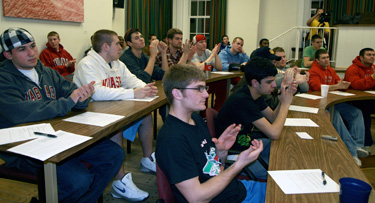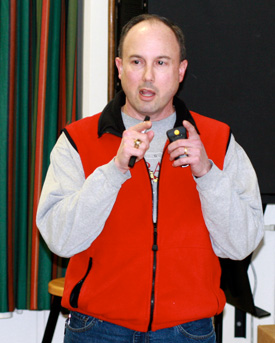The end to frigid weather has brought about the end of the WAR Council’s Six Pack Talks with the last talk called The ABC’s of BAC presented by Wabash College physician John Roberts ’83.
Dean of Students Mike Raters took the stage before Roberts reflecting on the 6 Pack Talks, and gave thanks for those who put the talks together.
"Every indication I’ve got, says it’s been an exceptional series." Raters said. He stressed those who attended spread the word about what they have learned.
Roberts came prepared with a lot of facts, statistics, and experience. "A lot of people don’t think of alcohol as a drug, but it’s the most used drug; it has drug-like effects on your body," he said. "About 1,700 students die every year of alcohol related causes. So it’s a huge problem, you guys all know that"
 Around 600,000 get injured annually from alcohol-related causes, which Roberts said is prevalent on the Wabash campus with fights, punching walls etc. "Guys just don’t understand that the wall is not going to give, and the little bones in their hand are. It’s estimated over an average lifetime that 360,000 college students around the country are going to die from alcohol related causes. "
Around 600,000 get injured annually from alcohol-related causes, which Roberts said is prevalent on the Wabash campus with fights, punching walls etc. "Guys just don’t understand that the wall is not going to give, and the little bones in their hand are. It’s estimated over an average lifetime that 360,000 college students around the country are going to die from alcohol related causes. "
The most startling factor was a guessing game for the annual cost of everything associated with alcohol use, within the students' age group. The guesses ranged from $17 billion to the guess of $20 billion; and the answer surprised the majority. The actual retail price for everything associated with alcohol problems was an astonishing $58 billion annually.
Those who drink are easily identifiable according to research: Men, men who are white, men in fraternities, and athletes are most likely going to drink. Freshman drinking, nationally, has dropped between the years of 2003 -2007.
"I don’t know if that’s a reflection of the type of people we are selecting to come here now, or is it just freshmen that come to college now aren’t drinking as much." Yet at Wabash from freshman to senior year, the amount of alcohol consumption is greatly increased.
Roberts gave a couple of tips on safe drinking. Consuming a maximum of about a drink an hour was the first tip. "You guys can laugh now because you know that hardly ever happens that guys would do one drink an hour." Roberts also stressed a second important thing is to know how much you drink, and knowing what is in your drinks "There was an issue at Monon Bell this year where somebody drank something that they had not seen mixed and ended up going to the hospital."
Roberts explained the consumption of alcohol and it absorption into the body. "When you take a drink of alcohol about 20-25 percent is absorbed in your stomach, and once it gets through your stomach it goes through your small intestine or the remainder of it - most of it, is absorbed
 Blood Alcohol Content is the total amount of alcohol in the body divided by body weight. BAC, surprisingly, may be higher for an obese person over someone underweight. The more water in one’s system, the less the alcohol affects that person. So someone who is obese, their fats take up room that would be used for a higher water composition.
Blood Alcohol Content is the total amount of alcohol in the body divided by body weight. BAC, surprisingly, may be higher for an obese person over someone underweight. The more water in one’s system, the less the alcohol affects that person. So someone who is obese, their fats take up room that would be used for a higher water composition.
"Think of your body as a bathtub, you consume alcohol and it gets absorbed into your body. It starts to fill up the bath tub, but the problem in a bathtub is that there is only drain, one size, and one constant flow." So your body keeps the alcohol stored because it can’t get rid of it quick enough. Food in one’s stomach before consuming alcohol helps keep alcohol in the stomach and not in the bloodstream, keeping the tub from filling up too quick and causing problems.
Roberts summarized the BAC charts into three main sections. "Point-06 to point-1 alcohol level is you're kind of feeling good, you’re getting the nice buzz going, not a lot of bad things going on, you start to lose your inhibition, getting a lot more friendly with the ladies (which you might not normally do with alcohol in your body). So this level of alcohol might not be a huge problem, just kind of getting along at a party. Once you get below that level that’s when you start to feel bad. You start to over-express yourself, these are the boisterous guys who had a little too much to drink or start to locate fights. They are starting to get mood swings, getting angry. Then once you get down to a .21 then we just consider that problem drinking. These guys are stuperous, staggering around, they’ve got no idea what they are doing, you can’t reason with them. They’re getting in fights, they’re falling down stairwells, and you know you get down to the bad things."
BAC can be kept down with some tips. Pace your drinking, keep track of what you’re drinking, try to stick to that one drink for the hour, give yourself some time between drinks, always eat, avoid punch bowls, you can dilute your drinks, move around, and stop drinking before the party is over.
If you have a friend who you think is on the bad side of the BAC chart Roberts explained there are a couple things you should and should not do, and a couple things you might not know. Do not give the intoxicated person under your care a cold shower, as that may actually harm the person by causing hypothermia. Do not give an intoxicated person food to eat to soak up alcohol for two reasons. The first reason is that is a catalyst to the probability the person may vomit, which may lead to asphyxiation. The second reason is unless the alcohol has just been consumed, it probably will already be in the person’s blood stream with little alcohol left in the stomach.
Coffee doesn’t sober anyone up, contrary to some popular belief. Last, alcohol level can rise during sleep. So if someone is really intoxicated, don’t think they are sobering up right away by falling asleep, make sure someone watches over them for an increased signs in intoxication.
Roberts explained the warning signs of alcohol poisoning. If your friend is breathing less than 8 times per minute Roberts stressed the word "BAD!" A period of apnea lasting 8 seconds or more is "BAD!" Inability to awake the person is "BAD!" If the person is cool/clammy bluish skin, is repeatedly vomiting, and/or having seizures these are also tell tale signs of alcohol poisoning and also "BAD!" With Alcohol poisoning comes the hard decisions of whether or not to call 911, especially if the intoxicated is underage. "If you’re at that point where you are like should I call, Should I not call? Call, and there’s no ifs, ands, or buts about it."
The ABC’s of the BAC are airway, breathing, and circulation. That is the list of things to do to make sure your friend is safe until the paramedics arrive. Airway is turning their head to the side to make sure they keep their airway open. Breathing is critical; if they are not breathing you may have to do mouth to mouth. Circulation is to stop bleeding if any, or start CPR if necessary until the paramedics arrive.
Robert suggested many different ways to get help with alcohol. Pay a visit to the Health Center, Counseling Center, Alcohols Anonymous, Collegedrinkingprevention.gov, and Brad21.org.
Photos by Alex Moseman '11